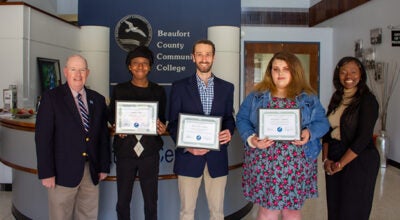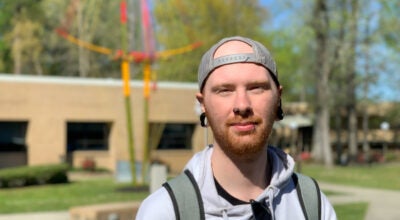Students campaign to change dress code
Published 9:31 pm Monday, November 12, 2012

Washington Montessori Public School students (from left) Zach Woolard, Noah Ausherman, United Nations vice president Anthony Boudreaux and United Nations president Jonas Snyder successfully campaigned to change school policy. (WDN Photo/Mona Moore)
Four students at Washington Montessori Public School managed to change school policy with a presentation made to the school board.
Noah Ausherman and Zach Woolard, members of the school’s United Nations (Montessori’s student government association), joined UN president Jonas Snyder and vice president Anthony Boudreaux in a project to change the school’s dress code.
They wanted the school to look at the uniform policy as a whole. They settled on getting officials to allow students to wear more than the standard black shoe and any color sock they fancied.
The group decided to support their argument for changing the school’s policy by talking to classmates.
The group polled students of all ages and videotaped a few interviews asking students for their views on the school’s dress code. Boudreaux said they asked open-ended questions and tried not to influence the answers.
“We wanted people’s opinions untouched by us. We just wanted the board to get a feel of what students wanted,” said Boudreaux, in his seventh year at Montessori. “We picked kids who had a good ability to vocalize their likes and dislikes.”
The group found that students had reasons for changing the dress code that hadn’t even crossed their minds. For instance, students with special needs said it was hard to find black shoes with the arch support they needed.
“We were hoping to completely reverse the policy,” Snyder said. “It’s hard to find a good, name-brand, solid-color shoe. It’s almost like you have to order them.”
The interviews were edited into a short film that was presented at a board of trustees’ retreat. (Well, actually a “rally,” not a “retreat.” The word “retreat” was replaced because, rather than taking a step backward (retreating), trustees sought to look and plan for the future. The dress code campaign fit into that plan).
Snyder, who is in his eight year at Montessori, said he had experience making video presentations when he campaigned for office.
“We tried to make it like a campaign video. It took us about a week and a half to kind of film it,” said Snyder.
Woolard, who is in his eighth year at the school, was surprised by the reception they received from the board. He said they weren’t nearly as “stuffy” as he expected.
“They were like the family members you don’t know,” he said.
Ausherman agreed. He said they approached the board as they were and had success.
“They weren’t intimidating, whatsoever. I was surprised at that,” said Ausherman, in his seventh year at Montessori.
The board granted a change in the sock policy, allowing students to wear any color they wanted, but stuck to the solid-colored shoe policy.
It was the first time in the school’s history that the student body had voiced opposition to school policy.
“I didn’t think that we were going to have a chance. I wasn’t very hopeful,” Boudreaux said.
The board encouraged the students to poll more of the student body and present an exhaustive list of the changes students wanted.
“We want them to realize there is power in their words,” said Jen Hales, interim head of the school.
Snyder said the board would hear more from them. They plan to attend the spring rally and revisit the shoe policy. The group also plans to request an expansion in school uniform colors and newer technology for student use.




